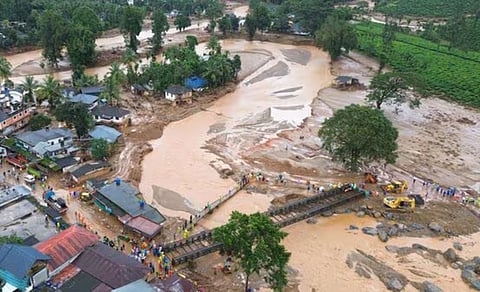

The landslides that killed hundreds of people in Kerala's Wayanad in early August were triggered by a burst of rainfall that was made about 10 percent heavier by human-caused climate change, the latest analysis by a team of leading scientists has found.
Researchers from India, Sweden, the US, and the UK warned that such events will become more common as the climate continues to warm.
The study by World Weather Attribution (WWA), an academic collaboration that studies the impact of climate change on extreme meteorological events such as heat waves, droughts, and storms, highlights the need for rigorous assessments of landslide risk and improved early warning in hillside regions of northern Kerala to prevent repeat landslide disasters.
WWA scientists analysed climate models with high enough resolution to accurately reflect rainfall in the relatively small study area. These models indicated that the intensity of rainfall increased by 10 percent due to climate change, the scientists concluded.
“Climate change has made single-day monsoon downpours in Wayanad about 10 percent heavier,” reads the analysis.
The analysis was published on the WWA website on August 14.
The study also notes that one-day bursts of monsoon rainfall will continue to become even heavier, risking even deadlier landslides, until the world replaces fossil fuels with renewable energy sources.
The analysis said that minimising deforestation and quarrying while improving early warning and evacuation systems will help protect people in northern Kerala from future landslides and floods.
The Wayanad landslide, which killed over 350 people, followed an exceptional spell of monsoon rain that lashed Kerala on July 30. More than 140 mm fell in a single day – equivalent to nearly a quarter of London’s annual rainfall, according to the WWA report.
It said the rain landed on soils that were already highly saturated, following two months of seasonal monsoon rains, triggering catastrophic landslides and floods in the Wayanad district. The 150 mm of rainfall that fell over 24 hours in Wayanad is the third heaviest on record in Kerala, the report said.
The study was conducted by 24 researchers in the WWA group, including scientists from universities and meteorological agencies in India, Malaysia, the United States, Sweden, the Netherlands, and the United Kingdom, the report said.
“The Wayanad landslides is another catastrophic example of climate change playing out in real-time. The extreme burst of rain that dislodged an entire hillside and buried hundreds of people was intensified by human-caused warming," said Mariam Zachariah, a researcher at the Grantham Institute - Climate Change and the Environment, Imperial College London.
The Wayanad landslides resulted in devastating loss of life and occurred in a mountainous region with loose, erodible soils after 140mm of precipitation fell on saturated soils.
In today’s climate, which is 1.3°C warmer than it would have been at the beginning of the industrial period, an event of this magnitude is expected to occur about once every 50 years.
-The event is the third heaviest one-day rainfall event on record, with heavier spells in 2019 and 1924, and surpasses the very heavy rainfall in 2018 that affected large regions of Kerala.
- Overall, the available climate models indicate a 10% increase in intensity. Under a future warming scenario where the global temperature is 2°C higher than pre-industrial levels, climate models predict even heavier 1-day rainfall events, with a further expected increase of about 4 percent in rainfall intensity.
-Given the small mountainous region with complex rainfall-climate dynamics, there is a high level of uncertainty in the model results. However, the increase in heavy one-day rainfall events is in line with a large and growing body of scientific evidence on extreme rainfall in a warming world, including in India, and the physical understanding that a warmer atmosphere can hold more moisture, leading to heavier downpours.
-While the linkage between land cover and land use changes and landslide risk in Wayanad is mixed in the limited existing studies, factors such as quarrying for building materials, and a 62 percent reduction in forest cover, may have contributed to the increased susceptibility of the slopes to landslides when the heavy rain fell.
-The increase in climate change-driven rainfall found in this study is likely to increase the potential number of landslides that could be triggered in the future, raising the need for adaptation actions that may include reinforcing susceptible slopes, landslide early warning systems, and construction of retaining structures to protect vulnerable localities.
(By arrangement with livemint.com)